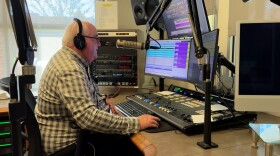In 1988, Americans were going to glam metal concerts, blockbuster movies and the mall in big numbers. But one place nearly half of Americans weren’t frequenting was the voting booth.
That year, when George H.W. Bush beat Michael Dukakis in the presidential election, the U.S. had its lowest voter turnout in 40 years. A dismayed Congress decided something needed to be done and in 1993 passed the National Voter Registration Act — also known as the Motor Voter Act.
The idea behind the federal law, which allows people to register to vote when they go to the DMV and other public assistance/state-funded programs or by mail-in application, is that more people would vote if there were fewer barriers to registration. Many states, including California, followed with their own motor-voter laws.
But fast forward to today and while registration has steadily increased in the decades since the laws were passed, turnout is still lagging.
“Before (California’s Motor Voter law), it was about 25% of the population that was not registered. And now we're down to about like 19%, 18%,” said Eric McGhee at the Public Policy Institute of California. “That's a pretty big change, right? But a lot of those people aren't turning out to vote more than we might like. And so the impact on voter turnout is attenuated by the fact that the people you're registering are not always thinking of themselves as voters.”
McGhee and other researchers noted the impact of state laws, which include California’s New Motor Voter Act passed in 2015 and an update in 2021.
Research published by the Center for Inclusive Democracy found that as a result of California’s New Motor Voter Act, voter registration at the DMV is one of the top registration methods for Asian-American, Latino, and Black registrants who registered for the first time or updated their registration.
In recent years, California built on the federal law with state legislation to mandate automatic voter registration (AVR), which eliminates the need for people to fill out a separate registration form at the DMV. But the impact of the new law is less effective unless it’s accompanied by deeper outreach, said Dora Rose from the League of Women Voters.
“It's really important to note that AVR doesn't immediately translate into high turnout,” Rose said. “For example, people who register through California's online system, where they have to actually proactively seek out registration, they turn out at much higher rates than the folks who are registering at the DMV ... that means that it's very important to take the next step, which is to do the education and outreach work that's necessary to translate new registrations into actual votes.”

Rocking the vote
The efforts in the 1990s went beyond the DMV and included the MTV generation. In 1992, Joel Shulkin was a sophomore at the University of New Hampshire. He was running a new voter registration program on campus.
Shulkin was also a REM fan. And on the back of the band’s Out of Time album was a petition for the Motor Voter bill — and a program called Rock the Vote.
The idea behind Rock the Vote was for celebrity volunteers to inspire young people to vote. Shulkin wrote a letter to Rock the Vote. After they responded, everything changed.
“I actually remember going door to door with Sarah Jessica Parker,” Shulkin said. “She would stop and just talk to students and insist on talking to them for like 10-15 minutes, until they finally agreed to go ahead and sign up to vote.”
Shulkin said with the help of Rock the Vote, they were able to register 10,000 new voters at the University of New Hampshire alone.
However, even with efforts like Rock the Vote, voter turnout and registration continued to have its peaks and valleys.
In California, a nadir came in 2014. Citing low turnout and lagging registration at the DMV, the League of Women Voters and other advocacy groups filed a noncompliance letter and eventually sued the state.
“Back in 2014, we saw a record low turnout period in California … You could really go one of two ways if you cared about this,” Mindy Romero, founder and director of the Center for Inclusive Democracy, said. “One was ‘wow, it's so low. Maybe we just give up the ship, you know nothing we can do.’ Or, ‘Oh, my gosh! We have to do something.’”
Rather than fight the lawsuit, state lawmakers passed the New Motor Voter Act. Implemented in 2018, the new law requires DMVs to electronically provide the records of eligible voters who didn’t opt out of voter registration to the secretary of state.
“We wanted to make sure that as people interacted with the DMV, because that's what was required from the federal legislation, that they were automatically registered and that you would have to take an affirmative step to not be registered,” said Lorena Gonzalez, a former San Diego County State Assemblymember and author of the New Motor Voter Act. “That way we would capture as many people as possible. And we did."
In 2021, additional legislation created a Motor Voter Task Force to consult with the secretary of state and the DMV on the implementation of the California New Motor Voter Program.
“What we've seen is that operation and compliance has really improved over time, and the new motor voter law has had a huge positive impact on registration,” Rose said.
In 2024, the task force is considering the addition of race/ethnicity to the registration process.
A new focus
The next level for advocates is to bring automatic voter registration to social service agencies like CalFresh and MediCal. Registrations from these agencies made up less than 1% of registered voters in the 2022 general election, according to research from the Center for Inclusive Democracy.
“While the New Motor Voter Act has made a difference with the DMV, enforcement with other agencies has been subpar,” said Brittany Stonesifer, a voting rights staff attorney for the ACLU of Northern California.
Regarding race and ethnicity, Romero and McGhee said it’s important to better understand who is registering. In other forms of registration, questions are asked about race and ethnicity, but not at the DMV.
“All we’re suggesting is there’s an inconsistent policy application here in California, and if people want a better voter rolls when it comes to the identification of race and ethnicity, more information (needs to be) made available to researchers to be able to do analysis by race and ethnicity on election reforms, that data can be used for other purposes as well,” Romero said. “The taskforce and other places might want to have a conversation.”
On Jan. 24, the task force discussed this change with the DMV. However, the DMV noted in the minutes from the meeting it is likely that the task force's suggestions for race and ethnicity would not be considered until 2028 at the earliest, if they don’t include a clear deadline.
Despite the initial shortcomings, Shulkin said we have a stronger democracy with motor voter laws.
“Having something like this, having a legislation where we're trying to remove obstacles, we're trying to show that we want you to go out and vote, and that you have a voice, I think, that really empowered (young people) and it helped to shift things, too,” Shulkin said.





